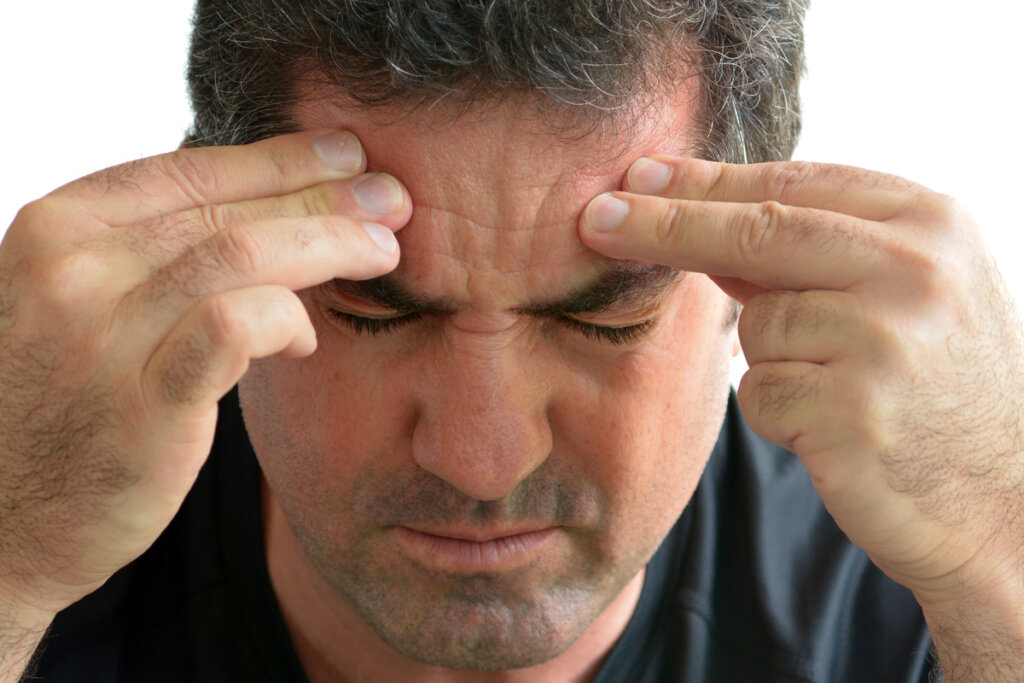When Does Anxiety Become a Psychological Disorder?


Written and verified by the psychologist Valeria Sabater
“I’ve been feeling really anxious lately, there must be something wrong!” There are times when your life comes crashing down on you and everything seems to be out of your control. You develop tachycardia, insomnia, and ruminant thoughts. You don’t know if you should be worried and start to wonder when it is that anxiety becomes a psychological disorder that must be treated clinically.
The fact that you’re asking yourself this question is a good sign. Because there are many people who live with these conditions without acting or asking for help. In effect, they normalize these highly pathological states. Therefore, being aware that you’re losing your quality of life and social functionality is an important step.
Currently, primary care services look after a large number of patients with anxiety. Although it’s true that many will be referred to specialized professionals, some don’t show more than simple stress and moderate anxiety. Indeed, not everything we feel, no matter how uncomfortable it may be, is pathological and needs a drug to alleviate it.
However, how can you tell the difference? Let’s take a look.
It’s important to know how to differentiate pathological anxiety from normal anxiety. Furthermore, it’s crucial to learn how to manage recurrent daily stress, before it gives way to a psychological disorder.

When does anxiety become a psychological disorder?
The subject of mental health has been recently gaining ground in the social arena. Depression, anxiety, bipolar disorder, eating behavior disorders (ED), etc are beginning to be normalized. Giving visibility to these conditions is allowing the population to become familiar with realities that are extremely common, that anyone can suffer from, and that, fortunately, can be overcome with adequate intervention.
Not all forms of anxiety require the prescription of anxiolytics. In fact, it’s worth remembering that this psychophysiological reaction sharpens our senses to allow us to respond more effectively to environmental demands. Therefore, events such as having problems at work or dealing with a specific concern can cause this emotion to appear.
Knowing how to differentiate normal anxiety from pathological anxiety is, without a doubt, an essential tool that you should learn. On the other hand, it must be remembered that, just because your current anxiety isn’t pathological, it doesn’t mean that in the near future it won’t become a disorder. Learning how to regulate your emotions and develop healthier mental approaches will always be a great help.
Let’s now discover the indicators that suggest anxiety is becoming a disorder.
Hypervigilance, the mind in search of threats
Works such as those conducted by the University of Delaware (USA) have investigated the point at which normal anxiety becomes pathological. They claimed that hypervigilance is one of the clearest indicators that people are falling into a worrying psycho-emotional state.
Hypervigilance is a state of greater sensory sensitivity in which the brain is oriented only to see threats and dangers where there are none. It translates into cognitive (thought) and also psychophysical overactivation. The mind won’t stop turning things over, transforming a grain of sand into a labyrinth with no way out.
Physical exhaustion is added to mental exhaustion, tuning into a continuous state of nervousness and constant stress.
Anxiety becomes a disorder when you stop having control over your life, you experience clear physical symptoms, and you can only foresee negative events.
Anguish: the latent fear that doesn’t let up
Anguish is constant fear, combined with the weight of existential emptiness, added to the permanent sensation of threat.
If you find yourself permanently in this state, don’t hesitate. It’s time to ask for help.
Brain fog, not being able to think or make decisions
Brain fog is a survival mechanism that activates your brain. When you feel in a state of great stress and anxiety, your brain chooses to reduce energy and resources. You limit yourself to acting on autopilot in order to reduce the great emotional load that’s taken you over.
This means you experience problems in focusing your attention, remembering things, making decisions, reflecting, thinking outside the box, etc.
Hopelessness and irrational fears
Your thoughts have an effect on whether your anxiety becomes a psychological disorder or not. Although the act of thinking doesn’t generate any sound, it does translate into a silent murmur of negativity and feelings of hopelessness about the future. In fact, your mind never stops. When it becomes chaotic, you start to think catastrophic thoughts that are of little use to you.
When this kind of state of negativity becomes a constant, you start to despair. It’s really important to detect its presence because, in some cases, it could also be an indicator of a depressive disorder.
Bear in mind that anxiety can sometimes present itself as a symptom of major depression.

When your body aches due to latent anxiety
Here are the physical indicators that suggest normal anxiety is becoming a psychological disorder:
- Tachycardias.
- Chest pressure.
- Digestive and/or intestinal disorders. For example, indigestion, nausea, and diarrhea.
- Muscle tension, in addition to back pain, neck pain, etc.
- Tingling or cramps.
- Sweating.
- Sleeping problems.
- Headaches.
- Unexplained tiredness.
Final reflection
If you’re suffering several of these symptoms and you suspect the possible presence of an anxiety disorder, you must request specialized help. The first step is to get a diagnosis. There are different types of anxiety, and even anxiety itself can exist alongside other conditions.
There are many interventions proven to be successful against anxiety. The role of psychotherapy is key, and in some cases, a pharmacological strategy may also be used. Ultimately, it’ll be the professionals who guide you in the recovery process.
“I’ve been feeling really anxious lately, there must be something wrong!” There are times when your life comes crashing down on you and everything seems to be out of your control. You develop tachycardia, insomnia, and ruminant thoughts. You don’t know if you should be worried and start to wonder when it is that anxiety becomes a psychological disorder that must be treated clinically.
The fact that you’re asking yourself this question is a good sign. Because there are many people who live with these conditions without acting or asking for help. In effect, they normalize these highly pathological states. Therefore, being aware that you’re losing your quality of life and social functionality is an important step.
Currently, primary care services look after a large number of patients with anxiety. Although it’s true that many will be referred to specialized professionals, some don’t show more than simple stress and moderate anxiety. Indeed, not everything we feel, no matter how uncomfortable it may be, is pathological and needs a drug to alleviate it.
However, how can you tell the difference? Let’s take a look.
It’s important to know how to differentiate pathological anxiety from normal anxiety. Furthermore, it’s crucial to learn how to manage recurrent daily stress, before it gives way to a psychological disorder.

When does anxiety become a psychological disorder?
The subject of mental health has been recently gaining ground in the social arena. Depression, anxiety, bipolar disorder, eating behavior disorders (ED), etc are beginning to be normalized. Giving visibility to these conditions is allowing the population to become familiar with realities that are extremely common, that anyone can suffer from, and that, fortunately, can be overcome with adequate intervention.
Not all forms of anxiety require the prescription of anxiolytics. In fact, it’s worth remembering that this psychophysiological reaction sharpens our senses to allow us to respond more effectively to environmental demands. Therefore, events such as having problems at work or dealing with a specific concern can cause this emotion to appear.
Knowing how to differentiate normal anxiety from pathological anxiety is, without a doubt, an essential tool that you should learn. On the other hand, it must be remembered that, just because your current anxiety isn’t pathological, it doesn’t mean that in the near future it won’t become a disorder. Learning how to regulate your emotions and develop healthier mental approaches will always be a great help.
Let’s now discover the indicators that suggest anxiety is becoming a disorder.
Hypervigilance, the mind in search of threats
Works such as those conducted by the University of Delaware (USA) have investigated the point at which normal anxiety becomes pathological. They claimed that hypervigilance is one of the clearest indicators that people are falling into a worrying psycho-emotional state.
Hypervigilance is a state of greater sensory sensitivity in which the brain is oriented only to see threats and dangers where there are none. It translates into cognitive (thought) and also psychophysical overactivation. The mind won’t stop turning things over, transforming a grain of sand into a labyrinth with no way out.
Physical exhaustion is added to mental exhaustion, tuning into a continuous state of nervousness and constant stress.
Anxiety becomes a disorder when you stop having control over your life, you experience clear physical symptoms, and you can only foresee negative events.
Anguish: the latent fear that doesn’t let up
Anguish is constant fear, combined with the weight of existential emptiness, added to the permanent sensation of threat.
If you find yourself permanently in this state, don’t hesitate. It’s time to ask for help.
Brain fog, not being able to think or make decisions
Brain fog is a survival mechanism that activates your brain. When you feel in a state of great stress and anxiety, your brain chooses to reduce energy and resources. You limit yourself to acting on autopilot in order to reduce the great emotional load that’s taken you over.
This means you experience problems in focusing your attention, remembering things, making decisions, reflecting, thinking outside the box, etc.
Hopelessness and irrational fears
Your thoughts have an effect on whether your anxiety becomes a psychological disorder or not. Although the act of thinking doesn’t generate any sound, it does translate into a silent murmur of negativity and feelings of hopelessness about the future. In fact, your mind never stops. When it becomes chaotic, you start to think catastrophic thoughts that are of little use to you.
When this kind of state of negativity becomes a constant, you start to despair. It’s really important to detect its presence because, in some cases, it could also be an indicator of a depressive disorder.
Bear in mind that anxiety can sometimes present itself as a symptom of major depression.

When your body aches due to latent anxiety
Here are the physical indicators that suggest normal anxiety is becoming a psychological disorder:
- Tachycardias.
- Chest pressure.
- Digestive and/or intestinal disorders. For example, indigestion, nausea, and diarrhea.
- Muscle tension, in addition to back pain, neck pain, etc.
- Tingling or cramps.
- Sweating.
- Sleeping problems.
- Headaches.
- Unexplained tiredness.
Final reflection
If you’re suffering several of these symptoms and you suspect the possible presence of an anxiety disorder, you must request specialized help. The first step is to get a diagnosis. There are different types of anxiety, and even anxiety itself can exist alongside other conditions.
There are many interventions proven to be successful against anxiety. The role of psychotherapy is key, and in some cases, a pharmacological strategy may also be used. Ultimately, it’ll be the professionals who guide you in the recovery process.
All cited sources were thoroughly reviewed by our team to ensure their quality, reliability, currency, and validity. The bibliography of this article was considered reliable and of academic or scientific accuracy.
- Barlow, D. H., Blanchard, E. B., Vermilyea, J. A., Vermilyea, B. B., & DiNardo, P. A. (1986). Generalized anxiety and generalized anxiety disorder: description and reconceptualization. The American journal of psychiatry.
- Borkovec, T. D., & Ruscio, A. M. (2001). Psychotherapy for generalized anxiety disorder. Journal of clinical psychiatry, 62, 37-45.
- Dugas, M. J., Gagnon, F., Ladouceur, R., & Freeston, M. H. (1998). Generalized anxiety disorder: A preliminary test of a conceptual model. Behaviour research and therapy, 36(2), 215-226.
- Rosen JB, Schulkin J. From normal fear to pathological anxiety. Psychol Rev. 1998 Apr;105(2):325-50. doi: 10.1037/0033-295x.105.2.325. PMID: 9577241.
This text is provided for informational purposes only and does not replace consultation with a professional. If in doubt, consult your specialist.







